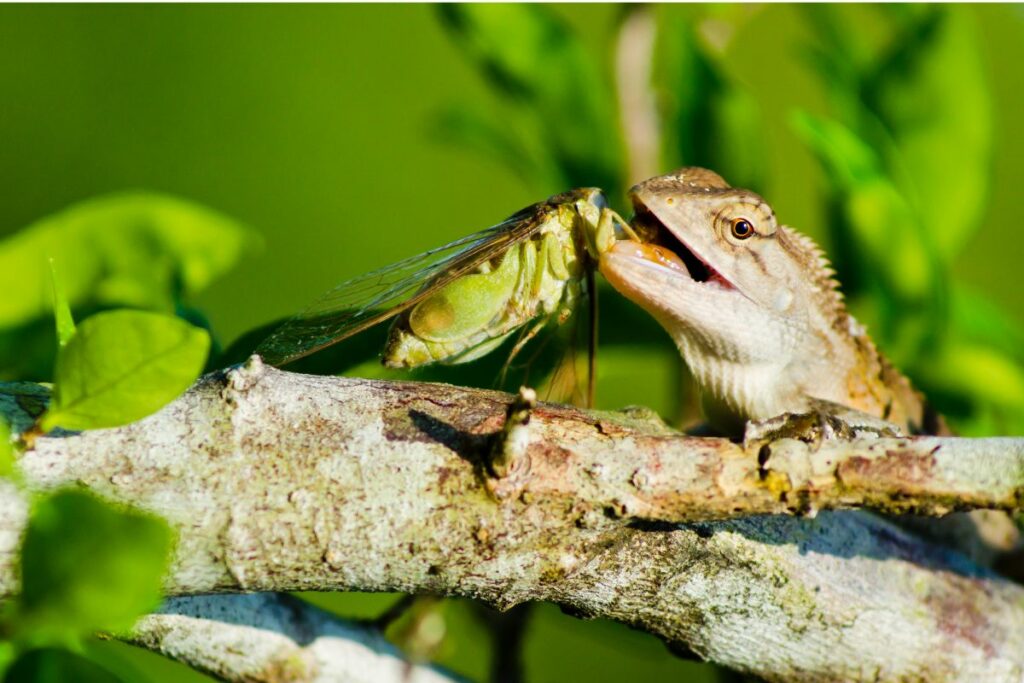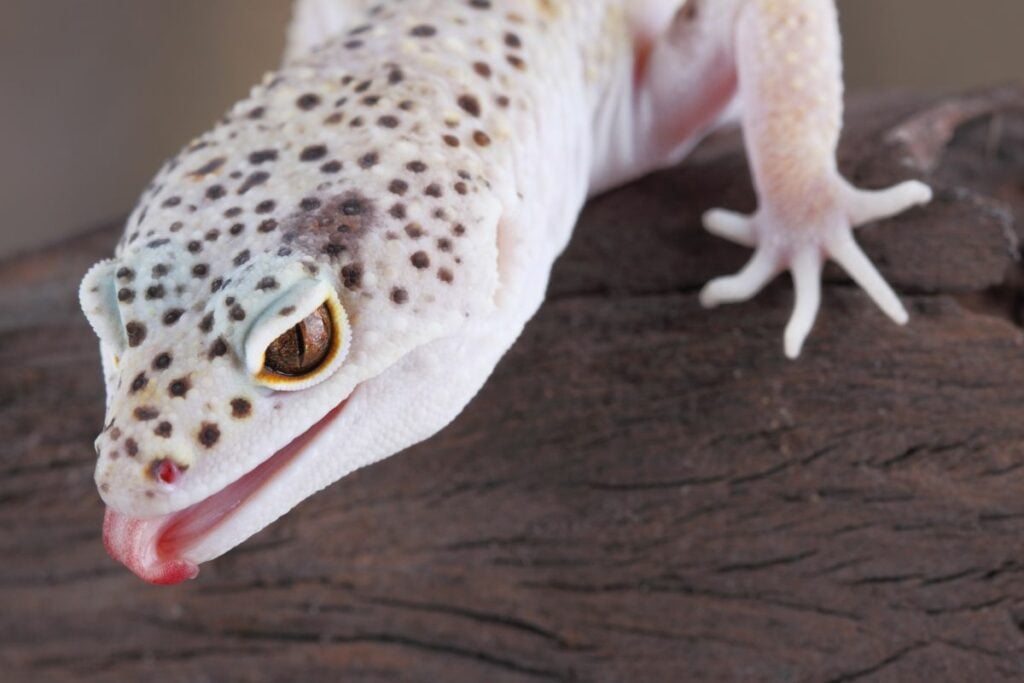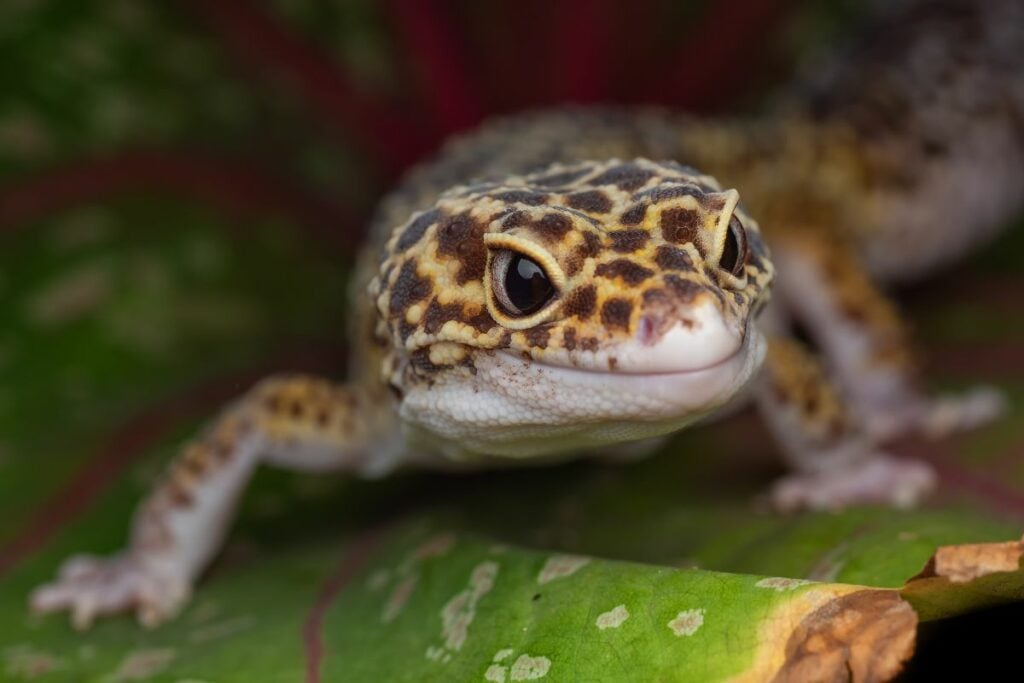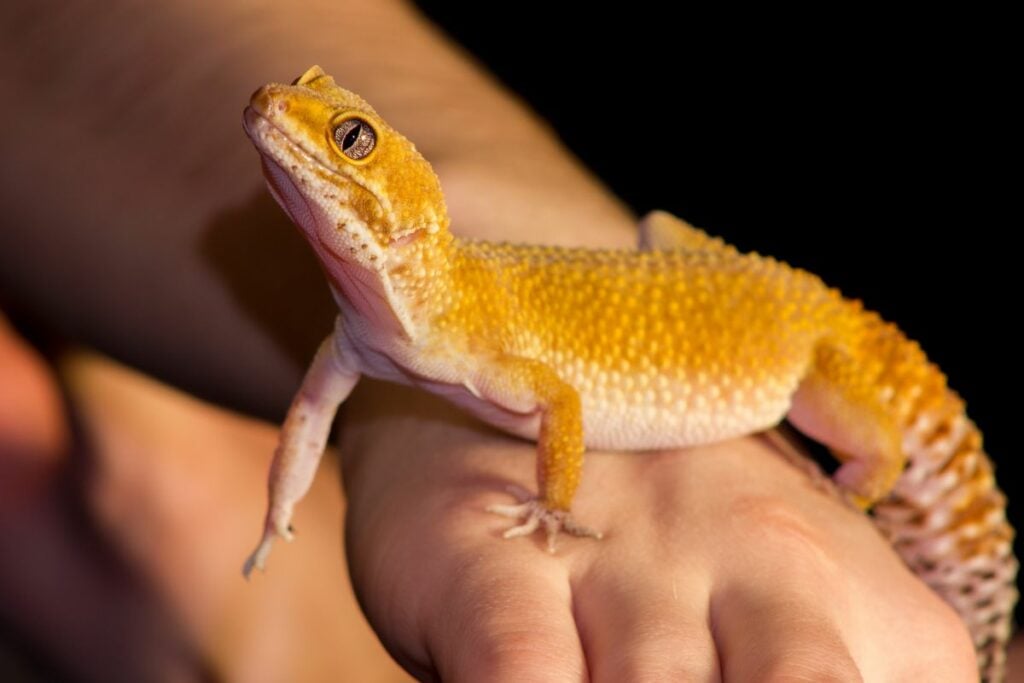Are you curious about what your little scaled friend can and can’t eat? Well, you’re in luck, because we’re here to answer all your questions about leopard gecko diets!
We all know that these adorable creatures are picky eaters and feeding them the wrong thing can have serious consequences.

That’s why we’ve put together this comprehensive guide to help you provide the best nutrition for your leopard gecko.
In this article, we’ll cover everything from the basics of leopard gecko nutrition to the ideal feeding schedule, to the best vitamin supplements, and more.
We’ll also give you the lowdown on commercial foods and how to choose the best one for your gecko, so by the time you finish reading you’ll be a leopard gecko feeding expert!
Are you ready? Grab your favorite snack (but not for your gecko, sorry!) and keep reading below!
How Do Leopard Geckos Obtain Nutrition From Food?
Let’s start with the basics, and to answer this question, let’s go on by saying that Leopard Geckos are carnivorous.
That means they eat mostly insects and other small animals, so don’t expect to see any rice and pasta in this article!
Leopard geckos have a pretty simple digestive system, with just a stomach and intestines and when they eat, their food goes into their stomach, where it’s mixed with digestive juices to break it down.
As the food moves through their intestines, nutrients are absorbed into their bloodstream; this is where calcium and vitamin D3 come into play.
So, when these creatures eat calcium-rich foods, like crickets, the calcium is broken down in their stomach and absorbed into their bloodstream.
The same goes for vitamin D3; when your gecko is exposed to UVB lighting, it helps its skin produce vitamin D3, which is also absorbed into its bloodstream.
Now, here’s where things get interesting!
Leopard Geckos are actually able to store excess nutrients in their bodies. So, if they eat a particularly calcium-rich cricket, for example, they’ll be able to store that extra calcium in their body for later use.
As a matter of fact, this is especially important for female geckos who need extra calcium to lay eggs, so if you have a lady in the room, make sure you take care of her!
Moreover, Leopard Geckos have pretty specific nutritional needs, meaning they require a high-protein diet, with plenty of fat and fiber as well.
This is why it’s important to offer a variety of live food options, as different insects will have different nutrient profiles.
Additionally, some gecko owners choose to supplement their gecko’s diet with vitamins and minerals to ensure they’re getting everything they need.
While we will look at all the food options in more detail further below, we should note at this point that, when it comes to your own gecko’s diet, it’s best to do your research and consult with a veterinarian if you have any concerns.
What Are The Basic Nutritional Needs Of Leopard Geckos?

As with any animal, Leopard Geckos have specific dietary requirements that need to be met in order for them to thrive, so let’s see some of the most important things you need to take into account.
As we mentioned earlier, Leopard Geckos are carnivorous, which means they eat meat. However, not all meat is created equal when it comes to its nutritional needs.
First and foremost, your gecko needs a diet that is high in protein. This is essential for their growth and overall health. Some good protein sources for geckos include crickets, mealworms, and waxworms.
In addition to protein, your gecko also needs a diet that is high in fat. This might sound counterintuitive, but fat is actually an important part of their diet as it provides energy and helps keep their skin and scales healthy.
Some good fat sources for geckos include mealworms, waxworms, and silkworms.
Fiber is another important part of your gecko’s diet as it helps keep their digestive system functioning properly and can prevent constipation.
Some good sources of fiber for geckos include fruits and vegetables, such as papaya and carrots.
Finally, we can’t forget about calcium and vitamin D3, which as we mentioned earlier are essential for your gecko, especially for its bone health.
Calcium
Calcium can be found in foods like crickets and mealworms, and vitamin D3 is produced when your gecko is exposed to UVB lighting.
Without enough calcium, your gecko can develop metabolic bone disease, which can lead to all sorts of health issues.
Therefore, to make sure your gecko is getting enough calcium, make sure to feed them calcium-rich foods, such as crickets that have been dusted with calcium powder.
Vitamin D3
Vitamin D3, on the other hand, is essential for the absorption of calcium in their bodies.
Without enough vitamin D3, even if your gecko is eating plenty of calcium-rich foods, it still won’t be able to properly absorb the calcium.
So, how do you ensure your gecko is getting enough vitamin D3? The best option is to provide them with UVB lighting.
This type of lighting mimics natural sunlight and helps your gecko produce vitamin D3 in their skin. Just make sure to provide a basking spot in their enclosure where they can soak up those rays!
What Can Your Leopard Gecko Eat?
So, what can your Leopard Gecko eat? The short answer is: a lot, and some of the options we have already mentioned a bit further above in this article!
For starters, since these little guys are carnivores, they need to eat meat to stay healthy.
The good news is that there are plenty of different insects you can offer them to keep their diet varied and interesting.
One of the most popular food options for Leopard Geckos is crickets. These little bugs are high in protein and easy to find at most pet stores.
Just make sure to gut-load them before feeding them to your gecko, which, in case you don’t know what it means, implies giving them a nutritious diet so that your gecko gets all those good nutrients too.
In addition to crickets, mealworms are another great option for your gecko. They’re a bit lower in protein than crickets, but they’re still a good source of nutrition.
Waxworms are a bit higher in fat, so they are also a good option if your gecko needs to put on some weight.
Silkworms and hornworms are a bit less common, but they are a couple of other great options. Silkworms, in fact, are particularly high in protein, while hornworms are a bit lower in protein but higher in water content.
In addition to insects, you can also offer your gecko small amounts of fruits and vegetables as treats, so long as you do your best to avoid anything that is high in sugar or acid, as this can upset their stomachs.
Nevertheless, it is important to note that not all insects are safe for your gecko to eat. For example, fireflies are toxic and should never be offered as food.
As a result, what we would highly recommend is that you stick to the insects we mentioned earlier, and you’ll be good to go.
Can Leopard Geckos Eat Fruits And Vegetables?
Yes, Leopard Geckos can eat fruits and vegetables, but you ought to keep in mind that they’re primarily insectivores, which means that insects should make up the majority of their diet.
When it comes to fruits and vegetables, you should offer them as treats rather than a staple part of their diet, meaning that fruits and vegetables should never make up more than 10% of your gecko’s diet!
Some good fruit options for Leopard Geckos include mashed banana, diced papaya, and sliced apricots. As for vegetables, you can offer things like chopped spinach, grated carrots, and diced bell peppers.
It’s also important to note that not all fruits and vegetables are safe for Leopard Geckos to eat and some examples of things you should avoid offering are citrus fruits, as they can cause digestive issues.
In addition to citrus fruits, be sure to avoid any fruits or vegetables that are high in sugar or calcium.
Finally, when offering fruits and vegetables, it’s important to do so in moderation. Just like with any other kind of food, overfeeding your gecko with fruits and veggies can lead to digestive issues, so it’s best to only offer small amounts as an occasional treat.
Should I Add Supplements To My Leopard Gecko’s Diet?

While a varied diet is important for Leopard Geckos, sometimes it’s not always possible to offer every nutrient they need, and that is where vitamin supplements come in handy!
Vitamin supplements can help ensure that your gecko is getting all of the necessary vitamins and minerals they need to stay healthy.
There are a variety of vitamin supplements available for Leopard Geckos, including those specifically designed for reptiles. Some common types include calcium supplements, multivitamins, and vitamin D3 supplements.
Calcium supplements are particularly important for Leopard Geckos, as they need calcium to maintain strong bones and prevent metabolic bone disease.
You can offer calcium supplements in the form of powder or liquid, and it’s important to ensure that they also contain vitamin D3.
Multivitamin supplements can also help fill in any nutritional gaps in your gecko’s diet; such supplements typically contain a range of vitamins and minerals, including vitamin A, vitamin B complex, and vitamin E.
Vitamin D3 supplements are also important for Leopard Geckos, as they need this vitamin to properly absorb calcium.
So, you can offer vitamin D3 supplements in the form of liquid drops, and it’s important to follow the dosage instructions carefully.
No matter which supplements you choose to offer to your leopard gecko when giving them it is extremely important to follow the dosage instructions carefully.
Needless to say, over-supplementing can be just as harmful as under-supplementing, so it’s important to find the right balance.
How Often Should You Be Feeding Your Leopard Gecko?
Now that you know what you can feed to your leopard gecko, we should move on to the next crucial things we promised to cover in this article, one of them being the frequency of their meals.
How often should you be feeding your Leopard Gecko depends on its age and size.
Generally speaking, adult geckos can be fed every other day or every two days, while younger geckos will need to be fed more frequently.
If your gecko is still a baby, it’ll need to be fed every day, and as they grow older and bigger, you can gradually decrease the frequency of its feedings.
In addition to the frequency of feedings, it’s also important to establish a feeding schedule for your gecko that will help them develop a routine and ensure that they’re always getting the food they need.
How Much Food Should Leopard Geckos Be Fed?
When it comes to feeding your Leopard Gecko, it is also important to remember that less is often more. These little guys have small stomachs, and overfeeding can lead to obesity and other health issues.
Therefore, it’s best to only offer your gecko as much food as it can eat in one sitting. This will help prevent them from overeating and ensure that they’re getting the proper amount of nutrition they need.
In addition to feeding the right amount of food, you should try to offer them a varied diet that will include a variety of insects and the occasional fruit or vegetable treat which will help keep your gecko healthy and happy.
If you’re ever unsure about how much to feed your gecko, it’s always a good idea to consult with a veterinarian or a reptile specialist.
As experts in this field, they can help you determine the appropriate feeding schedule and amount of food based on your gecko’s individual needs.
Can I Give Commercial Food To My Leopard Gecko?
Yes, you can give commercial food to your Leopard Gecko (see also “How Long Leopard Geckos Can Go Without Food“).
There are a variety of options available, including pellet and canned diets and it is true that these commercial foods can be convenient and provide a balanced diet for your gecko.
However, not all commercial foods are created equal, so it’s important to choose the right one for your gecko’s needs.
Advantages And Disadvantages Of Feeding Your Leopard Gecko With Commercial Food
Using commercial food can have advantages and disadvantages when it comes to feeding your Leopard Gecko.
Advantages
- Convenience: Commercial food can be convenient since it’s pre-made and ready to serve. You don’t need to worry about preparing or storing live insects or other fresh foods.
- Balanced nutrition: Some commercial foods are designed to provide a balanced diet for your gecko, with all the necessary vitamins and minerals included.
- Variety: Commercial foods come in a variety of flavors and forms, so you can switch them up and offer your gecko different options.
Disadvantages
- Lack of variety: Some commercial foods may not offer enough variety in the diet, which can lead to boredom or nutritional deficiencies.
- Cost: High-quality commercial foods can be more expensive than buying live insects or other fresh foods.
- Preservatives and additives: Some commercial foods may contain preservatives and additives that aren’t healthy for your gecko.
How To Choose The Best Commercial Food For Your Leopard Gecko
When it comes to choosing the best commercial food for your Leopard Gecko, there are a few things to keep in mind.
Here are some recommendations to help you make the best choice:
- Read the ingredients list: Make sure the commercial food you choose has high-quality ingredients that are beneficial for your gecko’s health. Look for foods that have real meat or insect proteins listed as the main ingredients.
- Check the nutritional content: Choose food that provides the right balance of nutrients, including protein, fat, and fiber. Make sure it also includes essential vitamins and minerals, like calcium and vitamin D3.
- Avoid fillers and preservatives: Some commercial foods may contain fillers and preservatives that can be harmful to your gecko. Look for foods with natural preservatives and avoid those with high levels of sugars or artificial additives.
- Choose age-appropriate food: Different commercial foods may be formulated for different life stages of Leopard Geckos. Choose a food that’s appropriate for your gecko’s age and size.
- Mix it up: Even if you choose a high-quality commercial food, it’s still important to offer your gecko a variety of foods. Supplement their diet with live insects and fresh fruits and vegetables to provide a well-rounded diet.
Common Feeding Problems And Solutions

As with any pet, feeding problems can sometimes arise when caring for a Leopard Gecko.
Picky Eating
One common issue is picky eating, where your gecko may refuse to eat certain foods or go through phases where they lose interest in their usual diet.
This can be frustrating for owners, but there are ways to encourage your gecko to eat. You can try offering a variety of different foods to see what they prefer, or even try offering food in different ways, such as cutting it into smaller pieces or offering it at different times of the day.
Feeding Aggression
Another problem that can occur is feeding aggression, where multiple geckos are competing for food and become aggressive toward each other.
To prevent this, you can try feeding your geckos separately or placing food dishes in different areas of the enclosure.
Constipation
Constipation can also be an issue for Leopard Geckos, which can be caused by a lack of hydration or an imbalance in their diet.
To avoid this, make sure your gecko always has access to clean water, and consider adding a small amount of moisture-rich food to their diet, such as fruits or vegetables.
In some cases, feeding problems may be a sign of a larger health issue, so it’s important to monitor your gecko’s eating habits and seek veterinary care if necessary (see also “Savannah Monitor Care Sheet“).
Overall, with a little patience and care, most feeding problems can be resolved, and your Leopard Gecko can continue to thrive on a healthy diet.
The Bottom Line
That’s it; you’ve reached the very end of what we hope was an informative and interesting article!
We covered a lot of ground in this article, discussing the basic nutritional needs of Leopard Geckos, what they can eat, how much they should eat, and even common feeding problems and solutions.
Remember that a balanced diet is crucial for the health and well-being of your Leopard Gecko. Offer a variety of insects and supplement with calcium and vitamin D3 to ensure proper nutrition.
If you’re considering commercial food options, be sure to choose a high-quality brand that meets your Gecko’s nutritional needs.
And don’t forget to pay attention to your Gecko’s behavior and appetite. Picky eaters, feeding aggression, and constipation are common issues, but with the right strategies, they can be easily resolved.
We hope this article has helped you become a better-informed Leopard Gecko owner, and that you’ll be able to provide your little pet with a nutritious and satisfying diet. Happy feeding!
- Can Leopard Geckos Eat Silkworms? - March 11, 2024
- Do Leopard Geckos Climb? - March 4, 2024
- Do Leopard Geckos Bask? The Answer Will Surprise You - February 21, 2024
